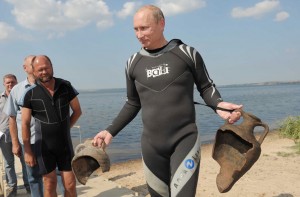Michael Shanks discusses two recent studies of the archaeology of socialist worlds: World Crisis in Ruin: The Archaeology of the Former Soviet Missile Sites in Cuba by Mats Burström, Anders Gustafsson and Håkan Karlsson and Persistent Memories by Elin Andreasssen, Hein B. Bjerck, and Bjørnar Olsen. The photos are deeply striking and hauntingly familiar for anyone who has worked in the former USSR or other now post-socialist communities.
Category: The Caucasus and Eurasia
New Exhibit Opening: Armenia, the treasures of a millenary culture
Venice hosts a multi-venue exhibition on the history and civilization of this Eurasian country from the dawn of Christianity to the 19th century. The exhibition kicks off the celebrations for the 500-year anniversary of the first book to be printed in the Armenian language
16 December 2011 – 10 April 2011
 On the 500-year anniversary of the printing of the first book in the Armenian language in Venice (1512), the Correr Museum, the National Archaeological Museum and the monumental halls of the Biblioteca Nazionale Marciana in Venice will host, from 16 December 2011 to 10 April 2012, an exhibition titled “Armenia. Footsteps of a civilization”. The event, which enjoys the high patronage of the Presidents of the Italian and Armenian Republic, will kick of the celebrations for the anniversary, which will continue with a rich bill of cultural events in the Armenian capital of Yerevan, which was recently named World Book Capital 2012 by UNESCO.
On the 500-year anniversary of the printing of the first book in the Armenian language in Venice (1512), the Correr Museum, the National Archaeological Museum and the monumental halls of the Biblioteca Nazionale Marciana in Venice will host, from 16 December 2011 to 10 April 2012, an exhibition titled “Armenia. Footsteps of a civilization”. The event, which enjoys the high patronage of the Presidents of the Italian and Armenian Republic, will kick of the celebrations for the anniversary, which will continue with a rich bill of cultural events in the Armenian capital of Yerevan, which was recently named World Book Capital 2012 by UNESCO.
The exhibition displays over 200 works from prestigious museums and libraries, arranged according to chronology and themes, and exploring the spirituality, art, architecture, economy, and thought of the Armenian people from the dawn of Christianity to the 19th century. Visitors will be able to admire ancient steles with engraved crosses, miniatures, sacred art documents, and precious reliquaries held for centuries in the Mother See of the Armenian Apostolic Church in Etchmiadzin.
Full story is here.
Last Refuge of the Neanderthals uncovered in the Urals?
Interesting new findings on Mousterian sites in the Urals suggest Neanderthal communities persisted in the Ural Mountains long after they disappeared from the rest of Europe and Asia.
Arslantepe Conference Live Stream: 12/5-12/7, 2011
Follow the convention in livestreaming!
From 5th to7th december it willbepossible follow the convention “Fifty years of Excavations and Researches at Arslantepe-Malatya (Turkey)” in livestreaming.
You can see the convention from the partner web site LiveStreaming and from the Sapienza University’s portal.
Watch live streaming video from uniroma1 at livestream.com
Eurasian Archaeology Conferences Move to Cornell
The Fourth Conference on Eurasian Archaeology
October 12-13, 2012
Cornell University
Fitful Histories and Unruly Publics:
Rethinking Community and Temporality in Eurasian Archaeology
The full CFP is available here.
UPDATE: Say it ain’t so Vladimir!
Putin’s Diving Exploit Was a Setup, Aide Says – NYTimes.com
MOSCOW — Vladimir V. Putin’s press secretary, Dmitri S. Peskov, says now-famous television video of the Russian prime minister diving to the bottom of a bay and discovering ceramic jugs from the sixth century was, in fact, a setup.
via Putin’s Diving Exploit Was a Setup, Aide Says – NYTimes.com.
Palaeoethnobotanical Data from the Early Bronze Age Settlement of Tsaghkasar-1, Armenia
New Paleobotanical report from the site of Tsaghkasar, courtesy of ArAGATS paleobotanist and current Fulbright Fellow, Roman Hovsepyan.
Medieval Novgorod
The second volume on the environmental context of Medieval Novgorod is forthcoming from Archeopress. Here a blurb on a complex and interesting project
Novgorod was one of the most important towns of medieval Russia and has wonderfully well-preserved archaeological deposits, in places over 7 meters deep, dating back to the mid-10th century. Due to the anaerobic conditions of the waterlogged site, both organic and inorganic finds are incredibly well preserved. This includes numerous finds of leather, birch bark, wood, textile, plant remains and so on as well as iron, bronze, and other metals, although like the organic material, these start to deteriorate when they are removed from the soil.
Russian archaeologists have been excavating at Novgorod since 1932 – every summer except during WWII. The results are internationally known, as they have revealed exceptional evidence not just of artefacts and their production but also the timber buildings, property boundaries, streets and defences of the town. Combined with the evidence for long-distance trade (Novgorod was an important member of the Hanseatic trading community), the town offers enormous potential for research projects of all shapes and sizes.
via Medieval Novgorod | Archaeology Group | Bournemouth University.
A Bioarchaeological Study from NW Armenia
Here is a link to a recently published paleopathology study of human remains from the Vardbakh and Sev Amrots I cemeteries in the area around Giumri (1st cent. BC-3rd cent. AD). http://www.anthropology.uw.edu.pl/04/bne-04-01.pdf. The complete volume of the journal is available here: www.anthropology.uw.edu.pl
